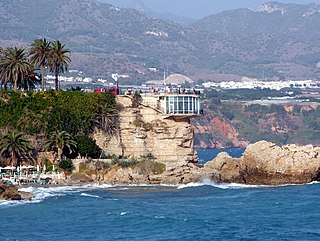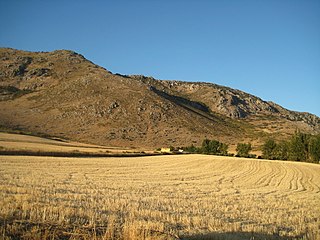Related Research Articles

The province of Málaga is located in Andalusia, Spain. It is bordered by the Mediterranean Sea to the south and by the provinces of Cádiz to the west, Seville to the northwest, Córdoba to the north, and Granada to the east.

Alta Velocidad Española (AVE) is a high-speed rail service operated by Renfe, the Spanish State railway company.

Ferdinand I named Ferdinand of Antequera and also the Just was king of Aragon, Valencia, Majorca, Sardinia and (nominal) Corsica and king of Sicily, duke (nominal) of Athens and Neopatria, and count of Barcelona, Roussillon and Cerdanya (1412–1416). He was also regent of Castile (1406–1416).

Antequera is a city and municipality in the Comarca de Antequera, province of Málaga, part of the Spanish autonomous community of Andalusia. It is known as "the heart of Andalusia" because of its central location among Málaga, Granada, Córdoba, and Seville. The Antequera Dolmens Site is a UNESCO World Heritage site.

Antequera, officially the Municipality of Antequera, is a 4th class municipality in the province of Bohol, Philippines. According to the 2020 census, it has a population of 14,990 people.

The Revolt of the Comuneros was a series of uprisings by settlers in Paraguay in the Viceroyalty of Peru against the Spanish authorities from 1721 to 1725 and 1730–1735. The underlying cause of the unrest was strong anti-Jesuit feelings among the Paraguayans and dislike for any governor seen as favoring the Jesuits. In the resumption of the revolt in 1730, economic issues came to fore as well. The rebel organization split in its second phase, as the rural poor and the urban elite each formed their own factions with similar grievances against the Jesuits, but incompatible politics. Paraguay had an unusually strong tradition of self-rule; the colonists did not have a tradition of strict obedience to everything the Spanish Crown's governor decreed. This independence helped push the revolt forward.

The Dolmen of Menga is a megalithic burial mound called a tumulus, a long barrow form of dolmen, dating from 3750–3650 BCE approximately. It is near Antequera, Málaga, Spain.
José de Antequera y Castro was a Panamanian lawyer and judge in the Viceroyalty of Peru who worked with the Real Audiencia of Charcas. He traveled to Paraguay to investigate allegations of corruption against Governor Diego de los Reyes Balmaseda. Controversially, he found Reyes guilty and then took the position of Governor of Paraguay for himself in 1721. He defended his position even against explicit instructions from the Viceroy of Peru to hand the Governorship back to Reyes, and rallied the militia to fight off attempts by Spanish authorities to push him out of power. However, his position eventually became untenable, and under the threat of an overwhelming military response, he fled the governorship. He was eventually arrested and executed.

The Autovía A-45 is an autovía in Andalusia, Spain, running from the Autovía A-4 at Córdoba to the Autovía A-7 at Málaga. It replaced much of the former N-331 road.

Campillos is a municipality and town in the province of Málaga, part of the autonomous community of Andalusia in southern Spain. It is located northwest of the province in the comarca of Guadalteba and within the judicial district of Antequera. The municipality is approximately 30 kilometers from Antequera and 70 from the provincial capital. It covers an area of 188 km2 extending from grain fields and olive groves and includes several lakes inhabited by flamingos and storks.

Fuente de Piedra is a town and municipality in the province of Málaga, part of the autonomous community of Andalusia in southern Spain. The municipality is located approximately 19 kilometers from Antequera and 73 km from the provincial capital of Málaga. It is located within the Antequera judicial district as well.

Antequera Club de Fútbol is a Spanish football team based in Antequera, in the autonomous community of Andalusia. Founded in 1992, it currently plays in Primera Federación – Group 2, holding home games at Estadio El Maulí, with a capacity of 6,000 seats.

The Dolmen de Viera or Dolmen de los Hermanos Viera is a dolmen—a type of single-chamber megalithic tomb—located in Antequera, province of Málaga, Andalusia, Spain. It is located only 70 metres (230 ft) from the Dolmen de Menga and about 4 kilometres (2.5 mi) of another structure known as Tholos de El Romeral. It was discovered between 1903 and 1905 by brothers Antonio and José Viera from Antequera, who also discovered El Romeral.

The Cathedral of Our Lady of the Assumption, located in the city of Oaxaca de Juarez, Oaxaca, Mexico, is the seat of the Roman Catholic Archdiocese of Antequera, Oaxaca. Its construction began circa 1535 and it was consecrated on 12 July 1733. It is dedicated to Our Lady of the Assumption.
Periglischrus is a genus of mites in the family Spinturnicidae. There are more than 30 described species in Periglischrus, found in South, Central, and North America, and in Africa.

The Comarca de Antequera is a comarca in Andalusia, southern Spain.
Antequera Zapotec is the dialect of Zapotec of 16th-century colonial documents such as Córdova 1578.
Antequera may refer to:
The Antequera Dolmens Site is a cultural heritage ensemble comprising three cultural monuments and 2 natural mountain features in and near the city of Antequera in Andalusia, Spain. The cultural institution responsible for its protection is the CADA. It was declared a World Heritage Site in 2016.
The 1826 Canary Islands storm was the worst weather-related disaster in the history of the Canary Islands, claiming at least 298 lives. It was likely either a tropical cyclone or a storm system derived from a tropical cyclone.